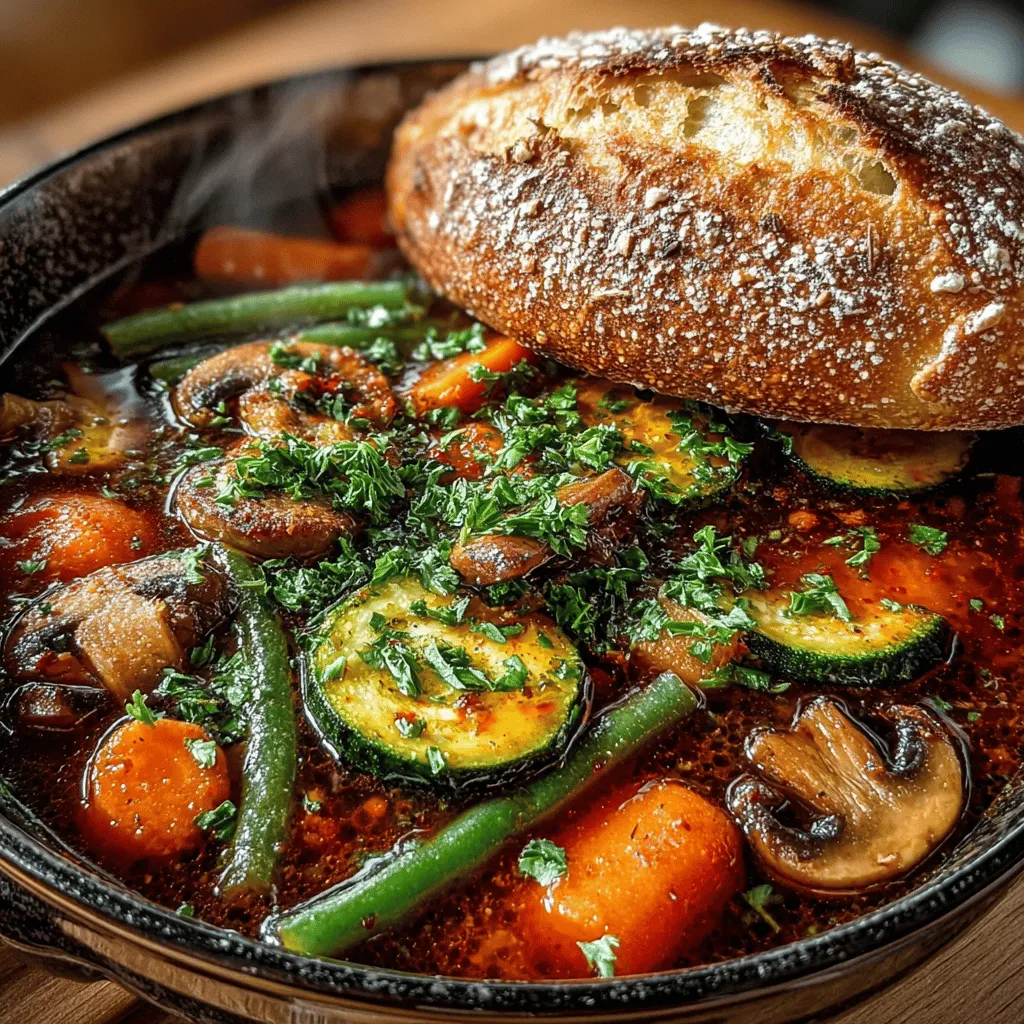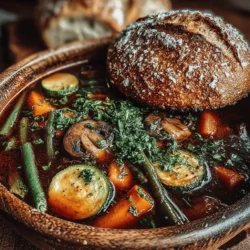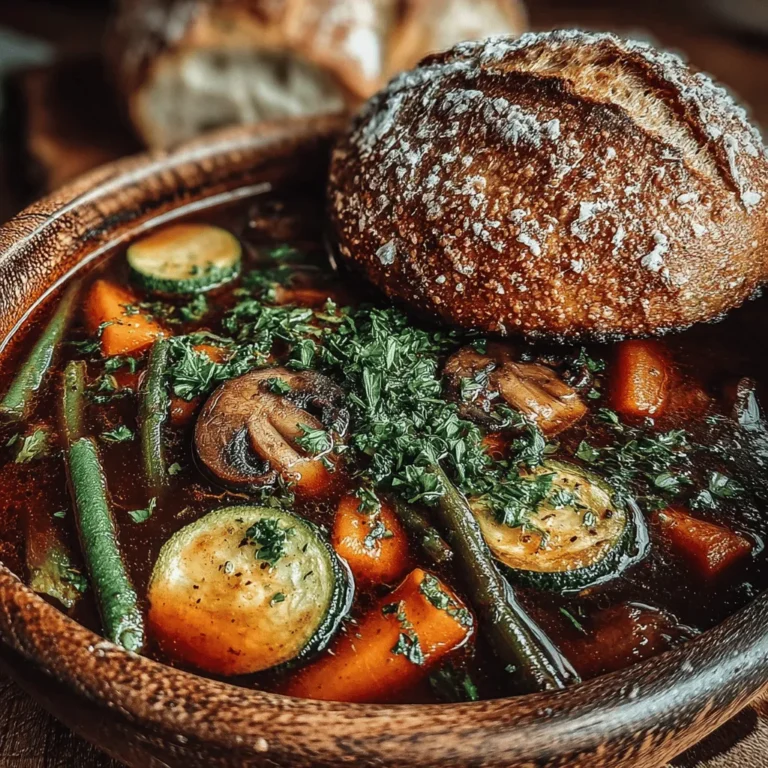Hearty Vegetable Stew with Rustic Bread: A Comforting Culinary Experience
There’s something profoundly comforting about a bowl of hearty vegetable stew paired with a slice of freshly baked rustic bread. This delightful combination not only warms the body but also nourishes the soul. In an age where our lives are often dictated by hectic schedules and fast-paced living, the importance of wholesome meals has never been more pronounced. Dishes that bring people together—like a steaming pot of vegetable stew—serve as a reminder to slow down and savor the moment. Whether it’s a family gathering or a cozy night spent at home, this recipe for hearty vegetable stew with rustic bread is perfect for creating cherished memories around the dining table.
Seasonal and comforting, this dish utilizes fresh, vibrant vegetables that reflect the bounty of nature. Each ingredient contributes its unique flavor profile and nutritional benefits, making it not only delicious but also a wholesome choice for any meal. The stew is a versatile option, as it can be easily adapted to include whatever fresh produce is available, allowing for endless variations to suit your palate.
Understanding the Ingredients
To truly appreciate the depth of flavor and health benefits of this hearty vegetable stew, it’s essential to understand the core ingredients that make up this nourishing dish.
Fresh Vegetables: The Heart of the Stew
The backbone of a great vegetable stew lies in its fresh ingredients. Key vegetables such as onions, garlic, carrots, celery, bell peppers, zucchini, mushrooms, potatoes, green beans, peas, and tomatoes work harmoniously to create a rich tapestry of flavors and textures.
– Onions and Garlic: These aromatic staples serve as the foundational flavor base, adding depth and complexity to the stew. Rich in antioxidants, garlic also boasts numerous health benefits, including immune support.
– Carrots and Celery: These vegetables contribute a natural sweetness and crunch, while also providing essential vitamins and minerals. Carrots are particularly high in beta-carotene, which is vital for eye health.
– Bell Peppers and Zucchini: These colorful additions not only enhance the visual appeal of the dish but also offer a wealth of vitamins, particularly vitamin C and potassium.
– Mushrooms: Known for their umami flavor, mushrooms add an earthy depth to the stew and are an excellent source of B vitamins and selenium.
– Potatoes: These hearty tubers add substance to the dish, making it filling and satisfying. They are also a good source of carbohydrates and dietary fiber.
– Green Beans and Peas: These vegetables provide a pop of color and sweetness, along with a variety of nutrients, including vitamins A, C, and K.
Herbs and Spices: Enhancing Flavor
No stew is complete without a thoughtful selection of herbs and spices. In this recipe, thyme and rosemary are the stars, infusing the dish with aromatic notes that elevate its flavor profile. A pinch of salt and pepper balances the overall taste and enhances the natural flavors of the vegetables.
Quality Vegetable Broth: The Foundation of Flavor
The broth is crucial in tying all the ingredients together, providing the liquid base that makes the stew hearty and comforting. Choosing a high-quality vegetable broth can make all the difference in achieving a rich and flavorful stew. Homemade broth is ideal, but store-bought options can also suffice if they are low in sodium and free of artificial additives.
Overview of Rustic Bread Ingredients
Complementing the hearty vegetable stew is rustic bread, which adds a chewy, crusty texture that is perfect for soaking up the savory broth. The ingredients for rustic bread are simple yet essential:
– Flour: The foundation of any bread, flour contributes structure and body. Bread flour, with its higher protein content, is often preferred for rustic bread, as it creates a desirable chewy texture.
– Yeast: This ingredient is responsible for the bread’s rise. Active dry yeast or instant yeast can be used, each offering a reliable way to achieve a light and airy loaf.
– Water: Essential for activating the yeast and hydrating the flour, water plays a key role in forming the dough.
– Olive Oil: Adding a touch of olive oil not only enhances the flavor of the bread but also contributes to its moisture, resulting in a tender crumb.
Step-by-Step Guide to Making Hearty Vegetable Stew
With an understanding of the ingredients in place, let’s dive into the preparation of the hearty vegetable stew.
1. Preparation of the Vegetables: Start by washing and chopping all vegetables into bite-sized pieces. This will ensure even cooking and make it easier to serve later.
2. Sautéing the Vegetables: In a large, heavy-bottomed pot, heat a couple of tablespoons of olive oil over medium heat. Add the chopped onions and sauté until they become translucent, about 5 minutes. This step is crucial, as it builds the flavor foundation for the stew.
3. Layering the Flavors: Once the onions are softened, add the minced garlic and cook for an additional minute until fragrant. Gradually introduce the carrots and celery, allowing them to sauté for about 3-4 minutes. This layering of flavors is essential; each vegetable should be given time to release its natural juices and meld with the others.
4. Incorporating Additional Vegetables: Next, add in the bell peppers, zucchini, and mushrooms. Stir occasionally, allowing these vegetables to soften and begin to caramelize, which will enhance their natural sweetness.
5. Adding Potatoes and Broth: Once the vegetables are nicely sautéed, stir in the diced potatoes, followed by the vegetable broth. The amount of broth can vary depending on how thick or soupy you want your stew. Bring the mixture to a gentle boil.
6. Simmering the Stew: Reduce the heat to low, cover the pot, and let the stew simmer for about 30-45 minutes. This slow cooking process allows the flavors to develop fully. Stir occasionally and check for tenderness in the vegetables.
7. Seasoning to Taste: After the vegetables have softened, taste the stew and adjust the seasoning with salt, pepper, and fresh herbs like thyme and rosemary. This is your opportunity to customize the dish to your liking, ensuring that every bite is packed with flavor.
With these initial steps, you are well on your way to creating a delicious hearty vegetable stew that pairs beautifully with rustic bread. As you continue to craft this culinary masterpiece, the anticipation will build for the comforting meal to come, perfect for sharing with loved ones or enjoying solo on a chilly evening. Now, let’s explore how to craft that rustic bread from scratch, ensuring a delightful accompaniment to your stew.

Detailed Instructions for Preparing the Dough
Ingredients for the Rustic Bread Dough
– 3 ½ cups all-purpose flour
– 1 ½ teaspoons salt
– 1 packet (2 ¼ teaspoons) active dry yeast
– 1 ½ cups warm water (approximately 110°F or 43°C)
– 1 tablespoon honey or sugar (to feed the yeast)
Step 1: Activate the Yeast
To ensure your rustic bread rises beautifully, start by activating the yeast. In a small bowl, combine the warm water and honey (or sugar). Sprinkle the yeast over the top and let it sit for about 5-10 minutes. You’ll know the yeast is activated when it becomes frothy and bubbly, indicating that the yeast is alive and ready to work its magic.
Step 2: Combine the Ingredients
In a large mixing bowl, combine the flour and salt. Make a well in the center and pour in the activated yeast mixture. Using a wooden spoon or your hands, mix until the dough starts to come together. If the dough feels too sticky, you can add a little more flour, a tablespoon at a time.
Step 3: Knead the Dough
Once combined, transfer the dough to a lightly floured surface. Kneading is crucial for developing gluten, which gives the bread its structure. Knead the dough for about 8-10 minutes, until it becomes smooth and elastic. You can tell it’s ready when it springs back after being pressed.
Step 4: Fermentation
After kneading, place the dough in a lightly greased bowl, covering it with a damp cloth. Allow it to rise in a warm, draft-free area for about 1-2 hours or until it has doubled in size. This fermentation process enhances the flavor and texture of the bread, creating a deliciously rustic loaf.
Step 5: Shaping and Scoring the Dough
Once the dough has risen, gently punch it down to release excess air. Turn it out onto a lightly floured surface and shape it into a round loaf or a long batard, depending on your preference. After shaping, use a sharp knife or a bread lame to score the top of the loaf. This not only allows the bread to expand as it bakes but also adds a beautiful decorative touch.
Baking the Perfect Rustic Bread
Oven Temperature and Baking Time Recommendations
Preheat your oven to 450°F (232°C). Place a cast-iron skillet or a baking tray on the bottom rack of the oven to create steam while the bread bakes, which helps achieve that crispy crust. Once preheated, place your shaped dough on a parchment-lined baking sheet. Bake the bread for approximately 25-30 minutes, or until it’s golden brown.
Signs to Look for to Determine When the Bread is Done
To check for doneness, tap the bottom of the loaf. If it sounds hollow, it’s ready to come out of the oven. You can also check the internal temperature with a kitchen thermometer; it should read around 190°F (88°C).
Cooling Tips for Optimal Texture and Crust Formation
After baking, transfer the bread to a wire rack to cool completely. This step is essential as it allows steam to escape, preventing the crust from becoming soggy. Avoid cutting the bread while it’s still warm; let it cool for at least 30 minutes for the best texture.
Serving Suggestions for Hearty Vegetable Stew and Rustic Bread
Garnishing the Stew with Fresh Herbs
Once your hearty vegetable stew is ready, serve it hot in bowls, garnished with fresh herbs like parsley or thyme. These herbs not only add a pop of color but also enhance the flavor profile of the dish, making each bite more aromatic and refreshing.
The Best Ways to Serve the Rustic Bread
For an authentic experience, slice the rustic bread thickly and serve it alongside the stew. You can also toast the bread lightly before serving for an added crunch, which complements the stew’s warmth. Consider spreading a little butter or olive oil on the bread for extra flavor.
Pairing Options: Wine, Cheese, or Salad
Enhance your meal by pairing the stew and bread with a light salad dressed in a simple vinaigrette. A glass of red wine, such as Pinot Noir or Merlot, pairs beautifully with the rich flavors of the stew. For a cheese addition, opt for a sharp cheddar or a creamy goat cheese that complements both the stew and the rustic bread.
Nutritional Benefits of the Dish
Overview of the Health Benefits Associated with a Vegetable-Rich Diet
The hearty vegetable stew is packed with a variety of vegetables, each offering unique vitamins and minerals. A vegetable-rich diet is known to support heart health, improve digestion, and provide antioxidants that combat oxidative stress. Incorporating various colors of vegetables ensures a wide range of nutrients, contributing to overall well-being.
Breakdown of Calories, Macronutrients, and Vitamins
A typical serving of hearty vegetable stew (about 1 cup) contains approximately:
– Calories: 150-200
– Protein: 5-7 grams
– Carbohydrates: 30-35 grams
– Fiber: 6-8 grams
– Fats: 3-5 grams (depending on added oils)
The rustic bread adds about 80-100 calories per slice, contributing carbohydrates and fiber, enhancing the meal’s satisfaction.
Discussion on Plant-Based Diets and Their Impact on Health
Embracing a plant-based diet, such as the one represented by this hearty vegetable stew and rustic bread, has been associated with numerous health benefits, including lower risks of chronic diseases, better weight management, and improved nutrient intake. The fiber from vegetables and whole grains supports healthy digestion and keeps you feeling fuller longer.
Conclusion
The combination of hearty vegetable stew and rustic bread is more than just a meal; it’s a celebration of wholesome ingredients and comforting flavors. Each bite of the stew brings warmth and nourishment, while the rustic bread adds a satisfying crunch, making it an ideal dish for family gatherings or cozy nights in.
Cooking is not just about feeding the body; it’s about nourishing the soul and creating moments to share with loved ones. The joy of preparing a home-cooked meal lies in the love and care put into each step, from selecting fresh ingredients to savoring the final product.
As you embrace this recipe, remember to enjoy the process, experiment with flavors, and most importantly, share your creations with those you care about. Home-cooked meals are an integral part of a healthy lifestyle, fostering connections and memories that last a lifetime. So gather your ingredients, roll up your sleeves, and get ready to indulge in the comforting embrace of hearty vegetable stew and rustic bread.


